Knowledge Management Guide
Table of contents.
Navigate guide
What is knowledge management?
Knowledge management (KM) as an established discipline dates back to the early 1990s, a starting point that is not a coincidence. Three trends were converging at that time, which coalesced around the idea of capturing and managing knowledge.
One trend was the emphasis on “core competencies” as the basis for competitive strategy. The prior generation had seen the rise and fall of the conglomerate model of business. As conglomerates spun themselves off into focused corporations, managers noted a disturbing pattern that threatened the core competency model: employees, the oldest of the baby boomers, were starting to retire. As they left the business, they took vital knowledge with them.
Knowledge was walking out the door, and with it, competitive advantage. This was not for a lack of data. There was plenty of data, but not enough knowledge. Business leaders found there was a gap between data and useful knowledge.
For example, a maker of musical instruments might have a database of raw materials to order to keep the production line running.
However, it’s not enough to know that you have to purchase centimeter-thick walnut boards to make a guitar.
That’s data. Knowledge is about how to turn that board into a guitar—and not just any guitar, but a good one, the kind that makes your company stand out in the market.
The subjective processes that turn a board into a guitar might be locked in the heads of workers who are retiring or quitting. Once they are gone, the recipe for making a good guitar will be permanently lost. KM sought to solve this problem.
The third parallel trend at the time was that of accelerating computing power. Though the computers of 30 years ago may seem slow and quaint by today’s standards, they were revolutionary at the time: cheap, fast, and ubiquitous. Everyone in the company could have one, running knowledge management system software, into which they could enter all their special, hard-learned corporate knowledge.
These trends birthed the category of knowledge management. But what exactly does that mean?
Knowledge management definition
Knowledge management is a multidisciplinary discipline that aims to create and share knowledge that is particular to a given organization. The goal of KM is to preserve organizational knowledge so that employees can make good use of it in serving customers and being innovative in product development, operations, and beyond.
KM is about making the right knowledge available to the right people at the right time to, according to Peter Drucker, “create benefit and competitive advantage.” It encompasses the creation, storage, and sharing of knowledge to drive value and meet organizational goals.
To understand knowledge management, it’s important to first understand what exactly “knowledge” is. Data, information, and knowledge are often used interchangeably—but they are not the same things.
- Data is defined as raw facts and figures that are unformatted. Data is essentially meaningless without being interpreted.
- Information is defined as data that has been processed so that inferences can be gained from the data, such as identifying patterns or trends. To become information, data has to answer “who, what, where, when, and why”.
- Knowledge includes the human additions of experience, context, and insight. It is the “know-how” that each person brings, based on their own experiences, values, and intuition. It is extremely valuable, but also very hard to pin down.
There are three different types of knowledge that KM has to shepherd through an organization:
- Explicit knowledge: This is knowledge that can be easily written and shared and includes things like manuals, databases, white papers, and case studies.
- Implicit knowledge: This is knowledge that hasn’t been documented but isn’t necessarily hard to codify. Some experts do not separate implicit and tacit knowledge.
- Tacit knowledge: This is knowledge based on personal experience that can’t be easily codified or explained. It is further complicated by the fact that many people don’t even realize the knowledge they have, or how or why it should be shared with others.
Examples of knowledge management in organizations
When a discipline is as broad as knowledge management, it can sometimes be difficult to understand its applications. Knowledge management has many use cases in organizations. Here are just a few examples. There are, of course, many more.
- Customer support: An enterprise search solution can be equipped with integrated knowledge discovery to help customer support people quickly turn seemingly random data points about a customer into coherent, useful knowledge. It can also automatically generate deep knowledge bases. Using Artificial Intelligence (AI), search-powered knowledge discovery software can access, surface, and structure insights from numerous data repositories. Customer support people, or anyone else in the organization who needs to know something, can search the resulting knowledge bases and deliver better service with access to quick and complete insights.
- Onboarding employees: Rather than overwhelming new employees with too much data and too many places to find it, KM can simplify the onboarding process with tools to help employees find what they need with ease. Instead of learning multiple systems and bookmarking dozens of locations, KM can help answer questions and make connections for employees.
- Innovation through collaboration: By giving employees a way to leverage current knowledge and create new knowledge in a collaborative space, KM creates opportunities to improve client service, innovate new processes and products, and gain competitive advantage.
Why is knowledge management important today
The explosion in data, information, and knowledge that was fueled by advances in computing technology led to a loss of control by managers and decision makers. Without a way to get their arms around the knowledge they had, organizations were missing opportunities, opening themselves up to risk, and wasting employees’ time searching for or recreating knowledge that already existed.
According to a study from the IDC, by failing to share knowledge, Fortune 500 companies lose more than $31 billion dollars a year. In the book Critical Knowledge Transfer, more than half of respondents to a survey said the knowledge-related costs of losing key employees could be as much as $300,000, and some responded that the cost was ‘priceless’. And a McKinsey report found that knowledge workers spend nearly 20% of their time searching for and analyzing information.
These numbers don’t lie. Failing to capture and share knowledge has a real impact on the bottom line. Knowledge management is a necessary discipline to help companies minimize losses and realize their full value and potential. In fact, a McKinsey Global Institute Report showed that implementing a knowledge management system can reduce information search time by up to 35 percent and increase productivity as much as 25 percent.
Knowledge management objectives
As we’ve defined it here, KM is about facilitating the capture and transfer of knowledge to serve a company’s goals. The objectives, then, of knowledge management are as follows:
- To understand what your organization knows, including: where or with whom the knowledge is located. In the mind of experts? Buried in a Sharepoint site? In Zoom recordings?
- To find the best way to share this knowledge with those who need it, and/or to save it from being lost. Should you implement a content management system, use an intelligent search platform, launch a mentoring program?
- To facilitate the ongoing creation and dissemination of knowledge. Create processes and trainings that make it easy to create and share knowledge, with incentives and rewards for those who champion the effort
- To continuously assess an organization’s knowledgebase as it relates to the organization’s goals, and adapt as needed to ensure the right knowledge is in place to succeed. Do you have the right team of experts? Are you storing knowledge that you no longer need?
- To turn knowledge into an asset, either by using that knowledge to generate revenue or to cut costs
Knowledge management benefits
Though KM is complex and often costly to implement, there are many benefits to a strong knowledge management initiative, including the following:
- Make faster, more informed decisions: KM puts the right knowledge into the hands of the right people so that they can spend less time searching and analyzing, and more time making business-critical decisions.
- Build your organizational memory: With knowledge management, enterprises can capture the knowledge held by long-term employees and experts and make it accessible to all, even after those employees have left. This preserves learnings for future employees, saving time and speeding innovation. It also helps companies learn from past mistakes and wins.
- Create more operational efficiency: KM saves time otherwise spent looking for information. This increases productivity and reduces costs. It can also help streamline onboarding and training.
- Improve collaboration: A robust KM program can break down silos between teams, and find ways to use knowledge from one department or project to inform or improve another team’s project, product, etc. It also provides transparency and fosters alignment between teams on goals and objectives.
- Identify knowledge gaps: In addition to helping companies benchmark the knowledge they have, KM also helps shine a light on the knowledge that they might be lacking. This can help organizations staff up or restructure to better meet their needs and goals.
- Keep your knowledge secure: KM helps an organization protect its most valuable knowledge, both from being lost or being copied. It also enables organizations to set permission controls so that certain information is only shared with certain people.
- Innovate and gain or maintain your competitive advantage: All of the benefits above come together to help an organization better innovate and differentiate.
How to drive knowledge management success
Knowledge management initiatives are notoriously difficult to implement and even harder to measure. Getting a handle on the scope of organizational knowledge and building frameworks and processes to enable the storage and transfer of knowledge is a hefty undertaking. But as an industry with decades of experience under its belt, there are some best practices that have emerged to help ensure a successful KM program:
Knowledge management best practices
- Be prepared to make changes to your organizational structure. The org chart of a company can impact how knowledge flows through it. The more siloed and separate teams and departments are, the more difficult it becomes to share insights. There’s no “right” way to organize – every company is different. But in general, studies indicate that flatter, more decentralized structures are more conducive to KM. When you embark on KM, look for barriers within the structure that may need to be removed, or other changes that can be made to improve the flow of knowledge.
- Create an organizational culture that encourages sharing. No initiative—KM or otherwise—can be effective if the beliefs, values, and attitudes of the company aren’t aligned with the effort. For KM to succeed, it’s crucial to build a culture that rewards sharing knowledge within and between teams. Employees must trust that doing so will be beneficial for them as well as for the company. Enabling “communities of practice” where experts from different parts of the organization can come together informally to collaborate and share is also a key tactic to create and share knowledge.
- Build a knowledge retention strategy. One of the main objectives of KM is to keep important knowledge within the organization. A knowledge retention strategy seeks to identify which knowledge is important, which knowledge is at risk of disappearing, and what steps need to be taken to keep that knowledge in-house. This includes figuring out how best to capture the knowledge, where to store it, and how to make it easily accessible.
- Implement easy-to-use KM systems and recruit champions to encourage adoption. The systems that will help an organization discover, share, and create knowledge need to integrate seamlessly into each employee’s workday. This is the most effective way to get company-wide buy-in, adoption, and ongoing use. Having leadership support and product champions to train employees on the system and encourage usage are also key to success.
- Be open to employee feedback and incorporate UFFA. Including employees in your KM plans, from informing the initial design to providing real-time user feedback improves favorability and adoption. Also be sure to include “Use it, flag it, fix it, add it” functionality to continuously improve your knowledgebase.
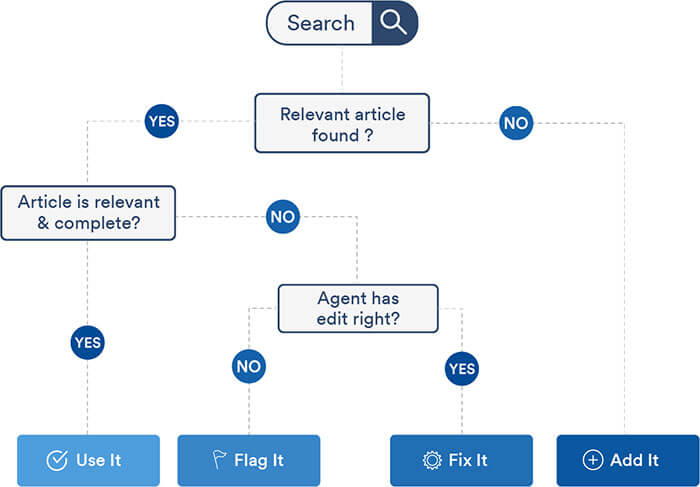
Knowledge management process
The knowledge management process is defined as “the management effort to promote and facilitate the activities of acquisition, storage, distribution and utilization of knowledge by individuals and groups” (Gonzalez and Martins, 2014; Cormican and O’Sullivan, 2003; Zheng et al., 2010; Liao et al., 2011).
The individual activities are defined as follows:
- Acquisition: The intra-organizational process that facilitates the creation of tacit and explicit knowledge, from the individuals and integrating at the organizational level, as well as the identification and the absorption of information and knowledge from external sources (Gold et al., 2001).
- Storage: The process of organizational memory formation (Walsh and Ungson, 1991), in which knowledge is formally stored in physical memory systems, informally retained as values, standards and beliefs that are associated with the organizational structure and culture (Alavi and Leidner, 2001), and also retained in the organizational processes, tools and routines (Kane and Alavi, 2007).
- Distribution: The process by which new information from different sources is shared and which eventually can drive the creation of new knowledge (Lee and Yang, 2000).
- Utilization: The ability of the individuals of an organization locate, access and use information and stored knowledge in the formal and informal memory systems of the organization (Rowley, 2001).
There are other versions of this KM process using different language, but the general concepts and steps are typically the same. For example, you may also see the process described as:
- Knowledge Discovery
- Knowledge Capture
- Knowledge Sharing
- Knowledge Application
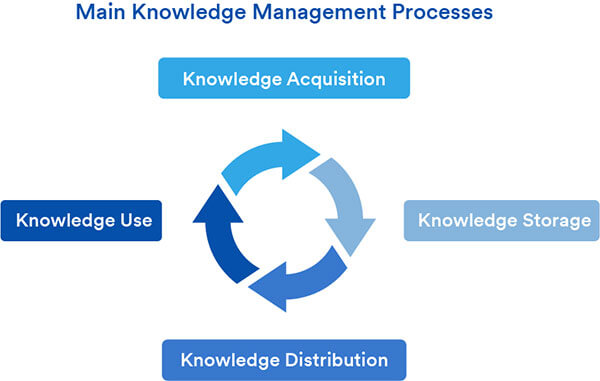
Knowledge management models
A KM model is a way of framing the KM process based on the unique needs and factors that affect a specific organization. For this reason, there are a variety of models that approach the process in different ways. Some are sequential and some are overlapping, but all deal with the basic components of knowledge capture, storage, sharing, and use.
Below are three popular knowledge management models. There are many more beyond these, including the Van Krogh and Roos Model, the WIIGS model, and the Boisot I-Space model.
Nonaka and Takeuchi SECI Model
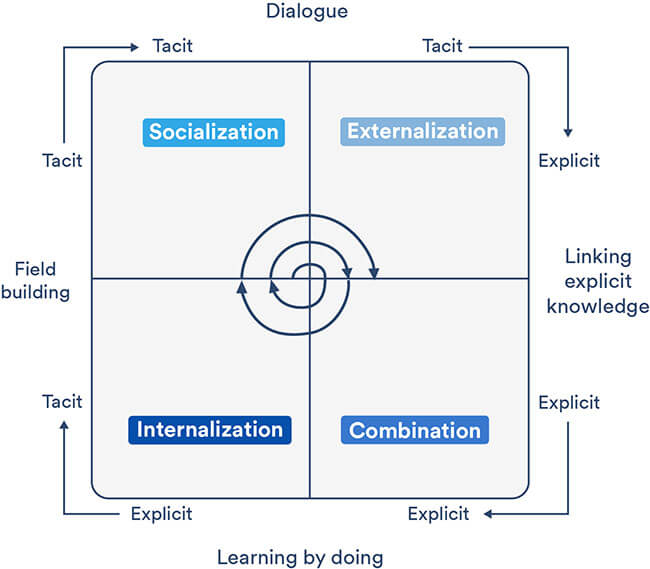
- Socialization is the sharing tacit knowledge in formal and informal communities and groups and is preceded by the creation of a physical or virtual space where a given community can interact on a social level. This is tacit to tacit knowledge conversion.
- Externalization is when tacit knowledge is transcribed in some form to enable sharing. Tacit knowledge is often difficult to codify, so this stage is the most challenging, but the most important. This is tacit to explicit knowledge conversion.
- Combination is when explicit knowledge sources are combined to create new knowledge. This is explicit to explicit conversion.
- Internalization is when explicit knowledge contributes to an individual’s tacit knowledge. This is explicit to tacit knowledge conversion.
Choo Sense-Making Model
This model looks at how the interconnected processes of sense-making, decision-making, and knowledge creation continuously feed the system.
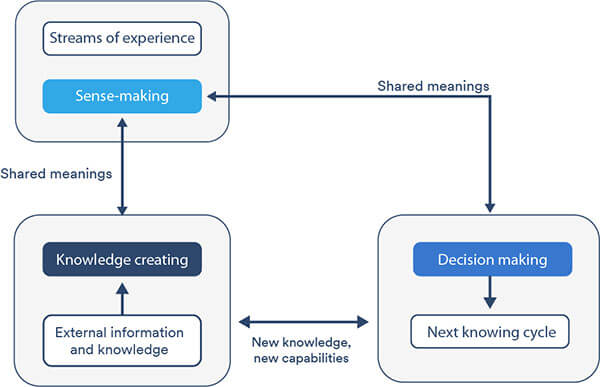
ZACK Model
The ZACK model focuses on the conversion of information to knowledge, with a unique “refinement” step where information is migrated, categorized, cleaned, and standardized.
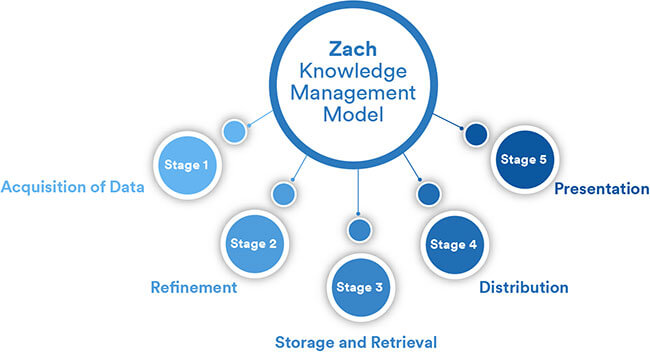
Knowledge management methods
There are a variety of ways that organizations can gather, share, and apply knowledge. Some of the more common methods are detailed here:
- Knowledge audit. This is a rigorous process that documents the location, ownership, and value of knowledge; identifies subject matter experts, and finds blockers to the flow of knowledge through an organization. The goal of a knowledge audit is to understand what an organization or subset of the organization knows, who knows it, what it doesn’t know, and how to address its KM issues.
- Knowledge mapping. A knowledge map “describes what knowledge is used in a process, and how it flows around the process. It is the basis for determining knowledge commonality, or areas where similar knowledge is used across multiple processes. Fundamentally, a process knowledge map contains information about the organization’s knowledge. It describes who has what knowledge (tacit), where the knowledge resides (infrastructure), and how the knowledge is transferred or disseminated (social).” (IBM Global Services – Technique Paper, 2000)
- Communities of practice. These are “a group of professionals informally bound to one another through exposure to a common class of problems, common pursuit of solutions, and thereby themselves embodying a store of knowledge” (Stewart 2001 in Botha et al 2008).” It is a way to bring experts with a shared interest together across disciplines to share and learn from each other.
- After Action Review (AAR). This is a debrief after a project to review what happened, why it happened, and capture lessons learned.
- Exit interviews. These can be a valuable tool for capturing knowledge from departing employees.
- Knowledge bases. These are collections, or repositories, or knowledge in the form of documents, FAQs, multimedia, links, etc.
How to measure knowledge management
KM initiatives are difficult to attach metrics to because they can impact so many areas of the business, often in ways that can’t be easily measured. A mix of qualitative and quantitative measures are often used to show the success of knowledge management, including:
- Employee satisfaction surveys. These can help organizations understand how KM has helped improve employees’ workday and their ability to get work done effectively.
- CSAT scores. If the KM initiative was focused on customer service, then measuring the impact on customer satisfaction scores before and after can be a good indicator of the success or failure of the program.
- Time to Resolution. An improvement in the time to resolution (TTR) can also show the impact of KM on customer service.
- Contributions. The amount and frequency of contributions to a knowledge base or Community of Practice can also help illustrate the level of adoption and usage of KM.
- Number of searches. The amount of searches performed and user rankings of the relevancy of results are also good indicators of adoption and usage.
- Onboarding/ramp-up time. The time it takes new employees to get up to speed is also a valuable measure of KM’s effectiveness.
Knowledge Management Glossary
KM includes many terms. Here’s a summary of the definitions of those we covered in this guide:
Knowledge management: Knowledge management is a multidisciplinary discipline that aims to create and share knowledge that is particular to a given organization. The goal of KM is to preserve organizational knowledge so that employees can make good use of it in serving customers and being innovative in product development, operations, and beyond.
Data: Raw facts and figures that are unformatted. Data is essentially meaningless without being interpreted.
Information: Data that has been processed so that inferences can be gained from the data, such as identifying patterns or trends. To become information, data has to answer “who, what, where, when, and why”.
Knowledge: Information that includes the human additions of experience, context, and insight. It is the “know-how” that each person brings, based on their own experiences, values, and intuition.
Explicit knowledge: This is knowledge that can be easily written and shared and includes things like manuals, databases, white papers, and case studies.
Implicit knowledge: This is knowledge that hasn’t been documented but isn’t necessarily hard to codify. Some experts do not separate implicit and tacit knowledge.
Tacit knowledge: This is knowledge based on personal experience that can’t be easily codified or explained. It is further complicated by the fact that many people don’t even realize the knowledge they have, or how or why it should be shared with others.
Organizational memory: the accumulated body of data, information, and knowledge created in the course of an individual organization’s existence.
Organizational culture: The underlying beliefs, assumptions, values, and ways of interacting that contribute to the unique social and psychological environment of an organization.



